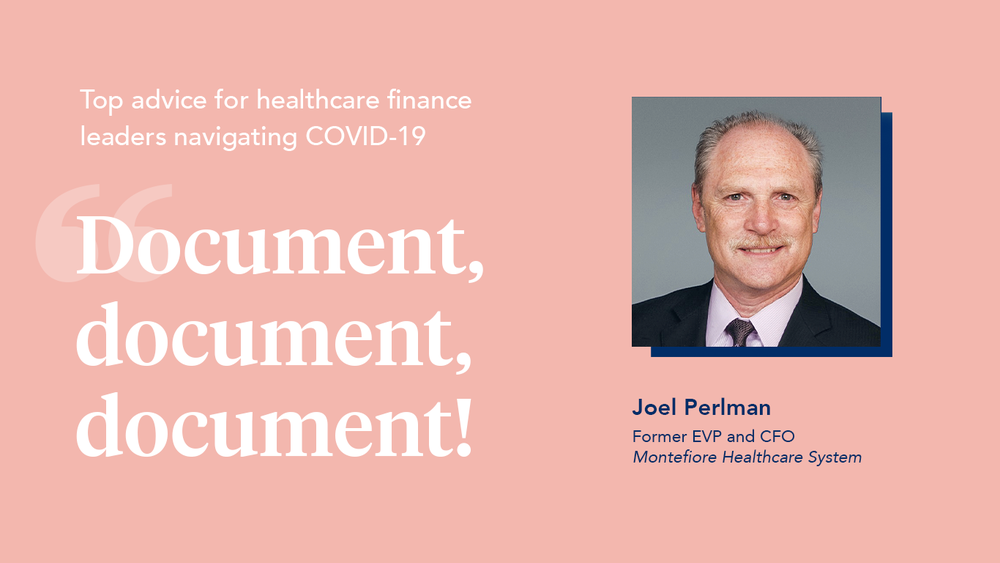Hospitals, health systems, medical groups and other provider organizations are currently confronting the massive financial fallout of COVID-19. The loss of revenue from ambulatory and elective procedures alongside a surge in costs have left healthcare providers and their finance leaders in a bind even as they deal with the urgent medical crisis. A recent analysis of proxy cases also estimated that most health systems can expect to lose money from caring for COVID-19 patients.
Given these pressing financial concerns, we sat down with Joel Perlman, CPA, former EVP and CFO of Montefiore Health System and Sr. Adviser to the CEO to get the finance leader’s perspective on navigating these difficult times. Summarized below is Joel’s analysis of the current situation and his top advice for healthcare finance leaders.
Big picture, what do you expect to be the financial fallout for hospitals in the next few months?
The financial impact has and will continue to be extraordinary. There will be different degrees of impact depending on geographic location and the incidence of the virus in various regions, but nationally COVID-19 has disrupted the healthcare economy in unprecedented ways. It will have a significant negative effect on most sectors of the healthcare provider ecosystem.
The most significant streams of negative financial impact include:
- Unanticipated costs associated with staffing and overtime, and extraordinary increases in certain supply and equipment expenses.
- Capital related expenditures in order to retrofit non-ICU areas and expand ICU bed capacity to accommodate COVID-19 patients.
- Lost revenue associated with the decline in utilization of elective and outpatient services and payer mix changes. While there’s been a marked growth in telehealth services, it’s hardly compensating for the drastic declines in utilization.
There will also be post-crisis effects that are harder to quantify such as the costs of unemployment insurance and health benefits associated with a high incidence of sickness in the healthcare workforce. Finally, the dramatic increase in unemployment across the nation will increase the ranks of the uninsured and cause a bump in Medicaid beneficiaries previously covered by commercial insurance.
How do you expect the CARES Act to help and what should finance leaders do to prepare?
While essential, there’s a general awareness that what’s been appropriated for the healthcare industry thus far is insufficient; there will be a need for supplemental funding and discussions in Congress are currently underway. The first $30 billion of the CARES Act is being distributed to hospitals based on historical Medicare fee for service revenue, an approach many fear will not adequately address the needs of hard-hit areas like New York, New Jersey and other COVID-19 hot-spots; nor those states with large volumes of Medicare Advantage patients. The CMS Medicare advance payments in progress are another source of welcomed immediate cash relief.
We’re hopeful that additional funds will be made available, but since the criteria is still evolving, there’s no assurances that adequate funds will be appropriated or equitably distributed based on need. It remains incumbent on every healthcare provider to do a very thorough job of identifying, quantifying and documenting the financial impact of COVID-19. At some point when additional funds open up, it’ll be critical to have complete documentation about the direct impact to an organization.
What lessons can healthcare leaders learn from previous disaster relief efforts?
I spent most of my career in New York, where we’ve had experiences in these types of disasters and relief efforts with the government. In 2012, Superstorm Sandy wreaked havoc on the healthcare industry in the NYC area. Fortunately, there was FEMA funding to enable recovery—to receive relief funds all healthcare provider organizations were required to document their costs and losses in detail, including personnel, supply, equipment, capital expenses and lost revenues, and were subject to audit. Finance organizations should be devoting resources within their teams to capturing all the relevant COVID-19 information in a standardized format in collaboration with other departments. Be thorough – document, document, document!
Are there any types of provider organizations that are particularly vulnerable to this financial crisis?
This is a universal crisis and it does apply to all providers – not just to acute care but also physician groups, sub-acute and community organizations. On the other hand, as noted above, there are variable impacts among healthcare providers and some organizations are being more profoundly impacted than others.
We already see the disproportionate impact of the virus on African-American, Latino and lower income communities. Correspondingly, there are clearly significant variabilities in the underlying financial strength of hospitals pre-pandemic. Safety-net hospitals, many rural hospitals and providers with high proportions of government payer patients were already under significant financial stress. The additional losses that these organizations face accentuate their needs for accelerated cash infusions to ensure continued operations. As noted, the current relief coming from the CARES Act and CMS Accelerated & Advance Payment Program are essential; future funds should be thoughtfully allocated and targeted, with a focus on the organizations that most require assistance.
You mentioned that safety-net hospitals tend to have a higher proportion of Medicare and Medicaid payments. Given the current economic crisis and corresponding loss of employer-sponsored insurance, should we expect to see more hospitals with this type of payer mix?
Yes, it is likely that the shifting payer mix will impact everyone for some period of time. The current COVID-19 surge in hospitalizations has been skewed towards older Medicare populations and communities with large Medicaid populations. However, even those hospitals that have a significant commercial payer mix in normal periods are experiencing a higher proportion of patients covered under government funded programs (and thus are receiving payment rates far below commercial payers). Virtually every provider organization will see an increase in their government payer mix and an increase in uncompensated care, which will adversely impact their financial condition and could continue for some period after the pandemic.
When it comes to dealing with patient financial responsibility, how should providers balance the need to collect for their services with the difficult financial circumstances that many patients are facing?
In my view, and the view of those organizations I have had the good fortune to have been affiliated with, it’s important to always have a patient-first approach. In this extraordinary period, I am confident hospitals will be hyper-sensitive to ensuring patients who need care receive it. Treat first, be mindful of the financial implications and document everything so that you have a basis for filing claims for relief funds which may become available from future government appropriations. But focus on the patient first.
There’s no question that in a healthcare economy in which an increasing amount of healthcare costs are borne by patients, that there will be issues with direct recovery from individuals. Hopefully, the government, commercial and private payers will be responsive and help compensate for the costs of this care; in my opinion, private insurers have an important role to play in assisting providers’ financial recovery.
For patients that receive service and legitimately can’t afford to pay their bills, we need to ensure that care and empathy are displayed by the provider organizations in handling that situation. Providers must work closely with patients on resolution options, including charity care and payment plans.
Last question, what is your top piece of advice to hospital finance leaders currently navigating this crisis?
Finance leaders are part of the executive team within every hospital and are working closely with their colleagues across the organization (those on the front-lines of patient care as well as support roles) to ensure that teams have everything that they need during this crisis. Everything you can do to support the team now, while also planning for financial recovery and long-term stability is essential.
Stay close to the things that you can have the most important impact on, including making sure you have the right documentation about the impact of COVID-19 on your organization. You may not recover funds that you are entitled to if you haven’t properly documented it.

Joel Perlman, CPA, is a Cedar Adviser. He served as the Executive Vice President, CFO of the Montefiore Health System until 2016. He continues to serve as a Sr. Adviser to the CEO at Montefiore and also presides on several boards, including CAQH-CORE, the New York Clinical Data Research Network and Healthfirst, Inc.



